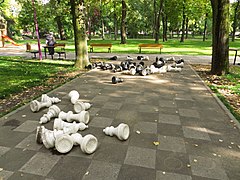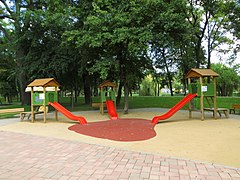Ion Creangă Children's Park
Tram lines 1, 2, 4, 10
Ion Creangă Children's Park (Romanian: Parcul Copiilor „Ion Creangă”) is a children's park in Timișoara that bears the name of Romanian children's author Ion Creangă.
Location
The park is located between the Bega Canal, the Michelangelo overpass and bridge, the ensemble of historical buildings on Constantin Diaconovici Loga Boulevard and Martir Leontina Bânciu Street. The Children's Park has two main entrances, the first one on Michelangelo Boulevard, and the second one on the 1989 Romanian Revolution Boulevard.
History
The development of the park began in 1858, in parallel with that of Coronini Park (present-day Queen Marie Park); the works were completed 33 years later, in 1891, and the new park was named Franz Joseph Park. The idea of this park started from the city council, which, around the preparation of the Agro-Industrial Exhibition in Southern Hungary (1891), saw an excellent possibility for the arrangement of the right bank of the Bega River.[2] The park kept its original name until 1919, when it was renamed Mihai Eminescu Park. For a very short period of time, between 1941 and 1945, the western part of the park was included in the Botanical Garden, established ad hoc, as a research base of the Botanical Institute of Cluj, which operated in the building of the Faculty of Hydrotechnics in Roses Park.[1] Between 1945 and 1955, when Russian military units were stationed here and in Roses Park, the park was abandoned and defaced. It was transformed into a children's park in 1986, according to a project by architect Mihai Donici.[3] At that time it was called Pioneers' Park (Romanian: Parcul Pionierilor).[4]
The Children's Park was closed to the public in 2004, when following an accident due to old and outdated installations, a child lost his life.[3] Later, following an investment of almost 2 million euros, the park was transformed and redeveloped. It was reopened in 2012 on Children's Day.[5]
Flora
Most of the current vegetation is represented by secular oaks, spruces, pines and other deciduous species. It is worth noting the presence of Ginkgo biloba specimens and softwood trees – willows, locusts, lindens, etc.[6] Among the ornamental and decorative plants can be found: roses, lavenders, azaleas, hibiscus, daffodils, chrysanthemums, violets, begonias, sages, etc.
Gallery
-
 Miniature replica of Princess Aurora's castle at Disneyland Paris
Miniature replica of Princess Aurora's castle at Disneyland Paris -
 Outdoor chess board
Outdoor chess board -
 Slides in Ion Creangă Children's Park
Slides in Ion Creangă Children's Park -
 The lighthouse
The lighthouse
References
- ^ a b c "Cadrul natural și peisagistic al municipiului Timișoara" (PDF). Primăria municipiului Timișoara. 2010. p. 23.
- ^ Kakucs, Lajos (2015). "De la Fântâna Pașei de pe lângă Mănăstirea Dervișilor până la Parcul Rozelor. Contribuții la istoria parcurilor din Timișoara" (PDF). Analele Banatului, S.N., Arheologie – Istorie. XXIII: 343–384. Archived from the original (PDF) on 2016-09-24. Retrieved 2021-07-03.
- ^ a b Both, Ștefan (15 November 2023). "Amintiri cu trenulețul diesel din Parcul Copiilor. Designerul Mihai Donici: „Era făcut de Regionala CFR după toate regulile"". Adevărul.
- ^ Păun, Liana (11 January 2015). "Parcurile orașului (II). Cum s-a născut orașul florilor și când au apărut locurile de agrement". pressalert.ro.
- ^ Deaconescu, Roxana (1 June 2012). "Parcul Copiilor a fost redeschis. Prichindeii timișoreni au avut parte de cea mai frumoasă surpriză de 1 iunie!". Opinia Timișoarei.
- ^ Iacobescu, Daliana (15 May 2015). "Parcul Copiilor". Merg.În.
Further reading

- Ciupa, V.; Oarcea, C.; Radoslav, R.; Oarcea, Z. (2005). Timișoara verde: sistemul de spații verzi al Timișoarei. Timișoara: Marineasa.
- Vișoiu, Dagmar (2001). Istoria grădinilor și parcurilor. Timișoara: Mirton.
- v
- t
- e
- Anchor Palace
- Baroque Palace
- Brück House
- Communal Abattoir
- Count Mercy House
- Dauerbach Palace
- Deschan Palace
- Dicasterial Palace
- Fabric Water Tower
- Hilt-Vogel Palace
- House with Atlantes
- House with Lions
- Huniade Castle
- Iosefin Fire Station
- Iosefin Water Tower
- Lloyd Palace
- Löffler Palace
- Merbl Palace
- Military Casino
- Mühle House
- Nägele Palace
- Neptune Public Bath
- Neuhaus Palace
- Old Town Hall
- Palace of Culture
- Prince Eugene House
- Prison
- Roman Catholic Episcopal Palace
- Șari-Neni
- Széchényi Palace
- Theresia Bastion
- Timișoreana Brewery
- Water Palace
- Weiss Palace

- Cetate Synagogue
- Elisabetin Greek Catholic Church
- Elisabetin Reformed Church
- Elisabetin Roman Catholic Church
- Fabric Greek Catholic Church
- Fabric Synagogue
- Fratelia Roman Catholic Church
- Iosefin Orthodox Church
- Iosefin Roman Catholic Church
- Iosefin Synagogue
- Lutheran Church
- Mehala Roman Catholic Church
- Metropolitan Cathedral
- Millennium Church
- Misericordia Church
- New Millennium Reformed Center
- Notre Dame Church
- Serbian Orthodox Cathedral
- St. Catherine Church
- St. Elijah Church
- St. George Cathedral
- St. George Serbian Church
- St. Nicholas Serbian Church
- Ana Aslan National College
- Banat National College
- Béla Bartók High School
- Carmen Sylva National Pedagogical College
- Central Library of Politehnica University
- Constantin Diaconovici Loga National College
- Eugen Todoran Central University Library
- Francesco Saverio Nitti Economic College
- Grigore Moisil High School
- Ion Vidu National College of Art
- Israelite High School
- King Michael I University of Life Sciences
- Nikolaus Lenau High School
- Piarist High School
- Politehnica University
- Sorin Titel County Library
- Tibiscus University
- Victor Babeș University of Medicine and Pharmacy
- West Technical College
- West University
fountains
gardens
- Alpinet Park
- Anton Scudier Central Park
- Botanical Park
- Cathedral Park
- Civic Park
- Green Forest
- Ion Creangă Children's Park
- Justice Park
- Queen Marie Park
- Roses Park
- Zoological Garden
- AFI Park
- Bega Business Park
- United Business Center
- Vox Technology Park













